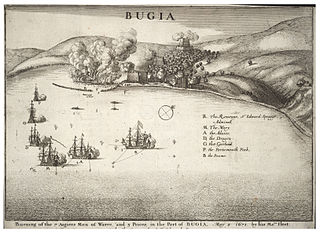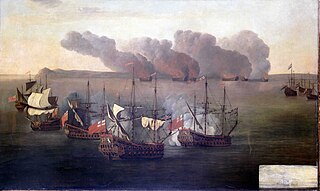HMS Rupert was a 64-gun third rate ship of the line of the Royal Navy, launched at Harwich Dockyard on 26 January 1666 and broken up in 1769.

The Prince Royal was a 55-gun royal ship of the English Royal Navy. It was later rebuilt and renamed HMS Resolution.
The English ship Speaker was a 50-gun third-rate. Speaker was built for the navy of the Commonwealth of England by Christopher Pett at Woolwich Dockyard and launched in 1650. At the Restoration she was renamed HMS Mary. She was the prototype of the Speaker-class.

The frigate Gloucester was a Speaker-class third rate, commissioned into the Royal Navy as HMS Gloucester after the restoration of the English monarchy in 1660. The ship was ordered in December 1652, built at Limehouse in East London, and launched in 1654. The warship was conveying James Stuart, Duke of York to Scotland, when on 6 May 1682 she struck a sandbank off the Norfolk coast, and quickly sank. The Duke was among those saved, but as many as 250 people drowned, including members of the royal party; it is thought that James's intransigence delayed the evacuation of the passengers and crew.
HMS Dreadnought was a 52-gun third-rate ship of the line, in service with the Royal Navy from 1660 to 1690.

Newbury was a 52-gun third rate Speaker-class frigate built for the navy of the Commonwealth of England at Limehouse, and launched in 1654. She was named for the Parliamentarian victories at the two battles of Newbury.
Bridgewater was a 52-gun third rate Speaker-class frigate built for the navy of the Commonwealth of England at Deptford, and launched in 1654.
Lyme was a 52-gun third rate Speaker-class frigate built for the navy of the Commonwealth of England at Portsmouth, and launched in 1654.

Marston Moor was a 52-gun third rate Speaker-class frigate built for the navy of the Commonwealth of England at Blackwall Yard, and launched in 1654.
Langport was a 50-gun third rate Speaker-class frigate built for the navy of the Commonwealth of England at Horsleydown, and launched in 1654.

President was a 38-gun fourth rate frigate of the Royal Navy, originally built for the navy of the Commonwealth of England by Peter Pett I at Deptford Dockyard, and launched in 1650.
HMS Assistance was one of six 40-gun fourth-rate frigates, built for the Commonwealth of England under the 1650 Programme, after the Restoration of the monarchy in 1660 she was incorporated into the navy of the Kingdom of England. During her time in the Commonwealth Navy she partook in the First Anglo-Dutch War being present in the battles of Kentish Knock, Portland and The Gabbard. In the Mediterranean she was present at the Battle of Santa Cruz and the bombardment of Porto Farina, In the Second Anglo-Dutch War she was involved in the Battle of Lowestoft, Battle of Vagen and the St James Day Fight. She did not participate in fleet actions after this. She spent the rest of her service life undergoing several rebuilds and plying the waters as a cruiser protecting British trade and projecting British sovereignty. After nearly 95 years of Service she was sunk as a break water at Sheerness at the end of 1745.

HMS Jersey was a 40-gun fourth rate frigate of the English Navy, originally built for the navy of the Commonwealth of England at Maldon, and launched in 1654. By 1677 her armament had been increased to 48 guns.
The Taunton was a 40-gun fourth-rate frigate of the Royal Navy, originally built for the Royal Navy by William Castle at Rotherhithe, and launched in 1654.

HMS Dover was a 40-gun fourth-rate frigate of the Royal Navy, originally built for the navy of the Commonwealth of England at Shoreham by William Castle, and launched in 1654. By 1677, her armament had been increased to 48 guns.
HMS Salisbury was a 50-gun fourth rate ship of the line of the Royal Navy, built at Chatham Dockyard to the dimensions of the 1706 Establishment, and launched on 3 July 1707. In autumn of 1707, she brought the body of admiral Sir Cloudesley Shovell from St Mary's to Plymouth prior to his burial in Westminster Abbey.
Mary Rose was a 24-gun ship in the service of the English Navy Royal. After commissioning she mainly served in Home waters. With the outbreak of the English Civil War in 1642 she was in the service of the Parliamentary Forces. She served until wrecked in a storm in March 1650.
Marigold was a 30-gun fourth rate vessel of the Kingdom of England, She was purchased from Portugal by Royalist agents then captured and commissioned into the Parliamentary Naval Force as Marigold. She conducted fishery protection duties, sailed to the West Indies and finally was with the Fleet off Cadiz. She was sold in 1658.
Amity was a 36-gun fourth rate vessel, formerly belonging to the Commonwealth of England. She was hired by Parliament in November 1649, and later purchased on 18 January 1650, thus renamed. She was commissioned into the Parliamentary Naval Force as Amity. During the First Anglo-Dutch War she partook in the Battle of Portland and the Battle of The Gabbard. Later, after the Restoration in May 1660, she was incorporated into the English Navy. During the Second Anglo-Dutch War she participated in the Battle of Lowestoft, the Four Days' Battle and the St James Day Fight. She was sold on 27 November 1667.








